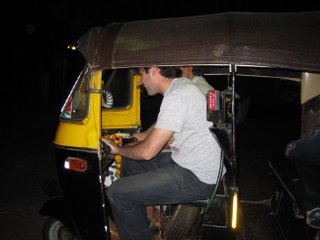To India and Back
Jacob Bailey's 10 week trip to India for an infectious disease internship.
Friday, March 31, 2006
Sunday, March 19, 2006
March 18, 2006
Here I am sitting in sweat for my last hour in India. Thank goodness I stored a change of knickers in my backpack. At the risk of future exploitation for this moment of truth I’ll let you all in on something. I can’t say no. Except for when the cabbie asked if he could drop off his bro on the way to the airport. But that was easy. When food is involved my answer is always a resounding yes. There it is. For the sake of a story I’m spilling the beans.
Instead of packing my last night, thereby making my Saturday morning available for last minute details, I ate with a doctor and his family. This is in no way a complaint. Not only was the cuisine delicious but the opportunity to spend time with a family was refreshing. One of my expectations for this trip was to develop relationships that would open windows to view life in India. I’ve had the pleasure of doing so by creating friendships with those around me here. So when I was asked to bring back pictures for the younger brother that lives in Salt Lake City, I didn’t hesitate to agree. Besides, this becomes another chance to meet new people and create bridges. Anyway, I gorged myself because I can never say no to seconds, or thirds, and waddled my way back home. That’s when I got the call from a former intern telling me that our mutual friend was having a birthday party and would like to see me before I left. So off I went. The party consisted of family and friends at a restaurant/lounge that his family rented out. This precipitated that I eat more, and not wanting to be an ungrateful guest I cleaned my plate. So I stayed out with the night owls till the cows came home and left my packing until this morning. This left me little time to get everything ready. Typical me.
For fun this time I want to pass along some of the funnier things I’ve heard and seen while sitting with doctors.
“Pharmaceutical companies would sell a comb to a bald man”
“Give me something good because she has exams coming up you know.” (A mother telling the doc to fill a prescription for antibiotics for her daughter with a cold)
“So doc, I don’t think it’s piles (aka hemorrhoids). It feels different.” patient
“No don’t worry, it’s not piles.” Doc
“So, what was it the guy had?” me about five minutes later
“Oh . . . it was just piles.” Doc
For all my fans out there—and when I say fans I mean you Mom—don’t worry, even though the Indian Adventure is ending as I write, the blog will continue. I still intend to share the rest of the journey home.
Wednesday, March 15, 2006
March 14, 2006
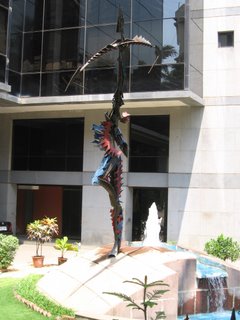 Happy Holi.
Happy Holi.Walking back to the Guest House from the hospital that we’ve been rotating through let me appreciate some things that I wouldn’t have seen otherwise. For one, the neighborhoods and the way they melt together, sometimes imperceptibly. The hospital is nestled in a neighborhood that seems to muffle the city from itself, almost blanketing the bustling streets with buildings and trees in such a way that at noonday the heat is balmy and the noise of traffic a hypnotic buzz. Spacious houses soon give way to apartment complexes with deceptively matching appearances. As major streets approach the din of midday traffic grows along with the frequency of stores and stalls until they reach a tumultuous climax at the train station. From swank to slum I walked and enjoyed the exercise, something I haven’t done lately.
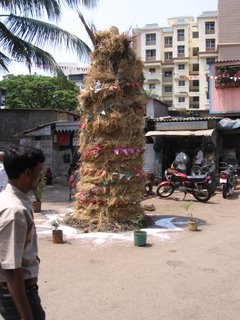 While walking I would come across mounds of straw laced with wood, logs and the occasional tire. These became the holi bonfires later tonight. From what I could gather, holi is a celebration of the triumph of good over evil. Holikha (questionable spelling) was a woman blessed with invincibility who sacrificed herself to confer this power to her nephew. He refused to worship his father who believed himself a god.
While walking I would come across mounds of straw laced with wood, logs and the occasional tire. These became the holi bonfires later tonight. From what I could gather, holi is a celebration of the triumph of good over evil. Holikha (questionable spelling) was a woman blessed with invincibility who sacrificed herself to confer this power to her nephew. He refused to worship his father who believed himself a god. 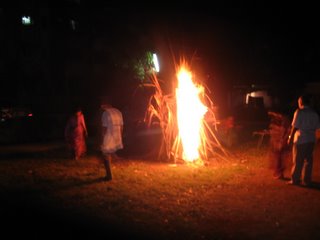 As punishment he was doomed to death by fire. Holikha decided she would let the boy sit on her lap and by so doing save him. Now, I’m not sure of the details of the story, or its completeness but this gives the gist. Holi officially starts tonight but the real fun begins tomorrow.
As punishment he was doomed to death by fire. Holikha decided she would let the boy sit on her lap and by so doing save him. Now, I’m not sure of the details of the story, or its completeness but this gives the gist. Holi officially starts tonight but the real fun begins tomorrow.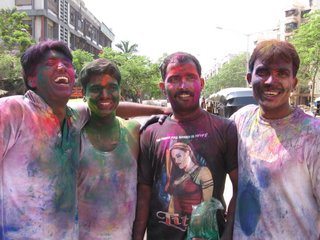 Holi is best known as the festival of colors. Dyes are sold from thousands of street stalls and friends, neighbors and strangers paint one another in reds, blues, pinks, purples and any other color imaginable. Clothes become casualties. Even water balloons and squirt guns are used. School kids and coworkers start the chaos early but the culmination of the festival is tomorrow afternoon with parties and bhang, a milk drink laced with hashish.
Holi is best known as the festival of colors. Dyes are sold from thousands of street stalls and friends, neighbors and strangers paint one another in reds, blues, pinks, purples and any other color imaginable. Clothes become casualties. Even water balloons and squirt guns are used. School kids and coworkers start the chaos early but the culmination of the festival is tomorrow afternoon with parties and bhang, a milk drink laced with hashish.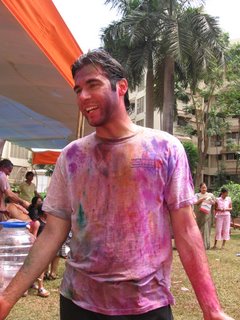 What better way to leave this country than looking like a box of melted crayons.
What better way to leave this country than looking like a box of melted crayons. 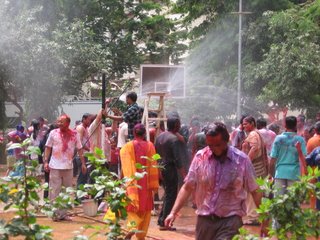
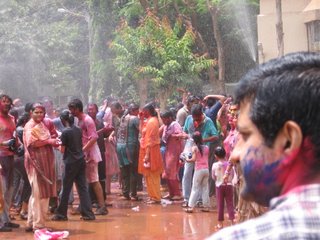
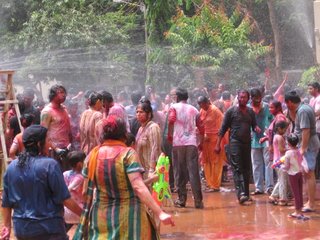
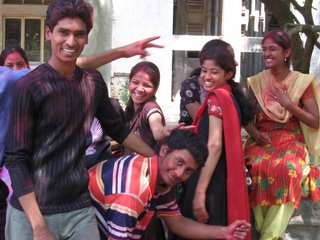
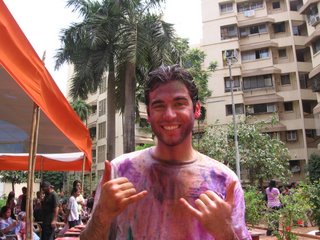
Sunday, March 12, 2006
March 9, 2006
The rain befits the day. After a lazy morning breakfast, I headed on to the hospital for the day’s rotation. I went through both male and female medical wards again since they were beneficial last time. I saw another case of rheumatic heart disease, something that I was told to be rare. It seems that they don’t get many acute cases anymore but still see people presenting heart failure due to it. I also was asked to take a blood sample from one of the patients. I felt fairly comfortable doing so since I have plenty of experience from my experiments at work, but I was still nervous for some reason.
They gave me gloves and a syringe and we walked over to the patient. The man’s arm was emaciated and strikingly scrawny in the nurses’ constricting grip. There was no tourniquet available other than her two hands and it was at this moment I realized they were going to let me do this without cleaning the patient’s arm with alcohol. How many times have I witnessed the ugly abscesses caused by dirty injections? I’ve even met a kid teasingly referred to as Swimming pool because of the gaping hole left by such an abscess. After a quick cleaning I took the blood while the guy cried more than anyone I’ve ever seen. And that was that.
As I approach the end of the internship my mind turns more and more towards home and the tasks ahead of me. The time has come where I’m excited to return, but thoughts of leaving are accompanied by melancholy. Acclimating to this new environment hasn’t proven to be difficult. Two years in Mexico City has acquaintanced me to sprawling metropolises in developing countries, and every day the similarities grow between the two, making the differences more enjoyable. Ten weeks has been enough time to develop fledgling friendships, making the experience more enjoyable, and short enough to be a pleasant respite from life back home.
Wednesday, March 08, 2006
March 6, 2006
 Today might end up being the best day of the internship. It’s not as if the other days were any less productive or fun. Perhaps I just appreciated the day more, or had a more positive outlook than other times. It started off like other days, but with the added complication of living in a separate accommodation from my companions. When I finally arrived at my destination, a municipal hospital named V N Desai, I had to wait around for the other students. We spoke briefly but effectively with the Medical Superintendent before moving on to our rotation. The attention she gave us was a reflection of how the rotation went. We first went through the male medical ward followed by the female medical ward. In both, the doctors were extremely nice and willing to teach. In the past, at other hospitals, the doctors usually did not have enough time for detailed instruction. This is understandable because of the sheer volume of work to be done. So as a result, we would spend a lot of time floating from one bed to another, or sitting in a chair while patients would flow past us in a constant stream of complaints, and consequentially see a large quantity of people but feel less edified at the end of the day.
Today might end up being the best day of the internship. It’s not as if the other days were any less productive or fun. Perhaps I just appreciated the day more, or had a more positive outlook than other times. It started off like other days, but with the added complication of living in a separate accommodation from my companions. When I finally arrived at my destination, a municipal hospital named V N Desai, I had to wait around for the other students. We spoke briefly but effectively with the Medical Superintendent before moving on to our rotation. The attention she gave us was a reflection of how the rotation went. We first went through the male medical ward followed by the female medical ward. In both, the doctors were extremely nice and willing to teach. In the past, at other hospitals, the doctors usually did not have enough time for detailed instruction. This is understandable because of the sheer volume of work to be done. So as a result, we would spend a lot of time floating from one bed to another, or sitting in a chair while patients would flow past us in a constant stream of complaints, and consequentially see a large quantity of people but feel less edified at the end of the day.This time we saw very few patients—no more than a dozen—but each person represented a new case to be explained and provided new insights as to how illness affects the body. A man suffering from tuberculosis was no longer just another case of TB, but became an opportunity to learn how different diseases affect the lungs and can be differentiated by x-ray. A woman with chronic obstructive pulmonary disease turned into a lesson on how lung problems create problems on other parts of the body. And once again I saw a rheumatic heart disease patient.
The woman was a young thirty-five. Thin and wasted. She had developed heart murmurs over the last few years and was presenting further complications. Too fit to suggest atherosclerosis or any such heart failures, and too old to hint at congenital heart defects, she was in need of surgery. Unfortunately she won’t be getting it. Too poor for any kind of corrective surgery, she will have to rely on prophylactic medication. Of course this means continuous compliance, something she’s probably too poor for as well. All this adds up to a very bleak future.
 After leaving the hospital I got to see an elephant.
After leaving the hospital I got to see an elephant.In the afternoon we spent about three hours at a place called Humsafar learning more about gay men in India. This is the only government sponsored outreach organization that targets gay men. Sodomy is illegal in this country and sex, especially gay sex, is extremely taboo. Humsafar provides counseling, community outreach activities, a medical clinic and HIV testing. We spoke with a couple representatives there and will go back tomorrow to talk with the counselors and doctors. Through all this we hope to see a larger picture of the HIV situation in this country. Cultural pressures are such that 27 % of homosexual men in Mumbai are actively involved in a heterosexual marriage as estimated by some studies. This is the most liberal city in India with probably the most open gay population. Tomorrow we hope to learn more about all this. It was interesting to see our coordinator’s reaction. She was obviously uncomfortable at the beginning of the visit and planned on leaving early to get back to her office duties. Eventually she stayed through the whole tour and seemed to enjoy the experience. When I asked her what her mother would say if she knew of the visit, she replied “She would kill me.”
Wednesday, March 01, 2006

I didn’t think much about all the commotion in the hallway when I walked the halls of V.N. Desai, a municipal general hospital. People always abound waiting for their ten minutes with the doctors. I didn’t think anything of the police guards posted at the entrance to the hospital and intermittently throughout the building. Most hospitals have some form of security and they seemed in place, as if their brown khaki uniforms made them fit in, almost match with the color of the building. It wasn’t until we returned home for lunch that we learned from the other students that problems broke out at another hospital.
Two of my companions were sent to another municipal general hospital, one which I had already visited weeks ago, only to return to the guest house due to a strike. It seems a patient accosted and struck a doctor there and in reaction the doctors went on strike. I’m not too familiar with how strikes go down here in India. I hear they occur often. It does seem a bit awkward to hear of doctors on strike though. How long it will last and how things run at a hospital without them is a mystery to me. We returned to V.N. Desai the next day and heard they were on strike as well. There was an obvious decrease in patients hanging around but it seemed the staff was working as per usual. Today, with the strike still in effect and growing to the other hospitals, we all went to different, private clinics. On the table lay the newspaper with its explanation.
The trouble began when Sumitra Walalvalkear (75), admitted on Wednesday
with respiratory and cardiac problems, died on Sunday afternoon.
When the doctor in charge, Dr. Rohan Inchwar, told daughter Chandrakala
that he did not know the cause of death and suggested a post-mortem, she
slapped him.
This is the second such case of violence at KEM this month. An FIR was
lodged at the Bhoiwada police station and, at 2 am, all doctors went on
strike. .
.
Currently, 2,500 doctors from 10 major hospitals—KEM, Bhabha,
Sion Hospital, B Y L Nair, Cooper, J J, St George, GT, Cama and Thane
Municipal Corporation Hospitals—have joined the strike.
Doctors at Bandra’s K B Bhabha Hospital went on strike after a similar
incident on Monday.
Heena Shaikh was admitted at 3 am with labour pains. Soon after, her
aunt Yasmin Sheikh entered the Labour Ward with her shoes on.
When the two doctors on duty, Dr Rujuta Bajaj and Dr Neepa Parikh,
stopped her, she slapped them. By 8 am, 65 doctors at
the hospital had gone on strike.
-Mumbai Newsline, Tuesday Feb. 28, front page
According to the same paper the demands of the doctors include among other things, 24-hour security, strict visiting hours for patient’s relatives, increase in stipend and non-bailable warrants for those guilty of violence against doctors.
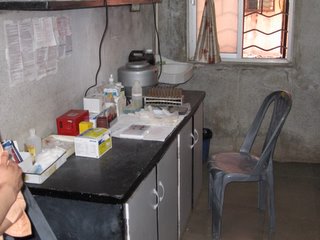 Before anyone starts worrying about safety conditions for us foreigners while we rotate through these hospitals, I just want to say don’t. Since the strike started we’ve adapted our daily plans. Even when we are in the municipal hospitals the situation is safe and we are nowhere near confrontational situations. The staff doesn’t want us to see such things, although I’m sure the more adventuresome people of the group would want to, and we’re not the target of hostility. It is a fascinating insight into the labor aspect of healthcare here. I couldn’t imagine a strike held by doctors. Sure, nurses can keep things running for the most part, especially in the wards with interned patients. They do most of the patient care at that point anyway. But, with a strike enacted who wants to go to the hospital? If for us it is an inconvenience to our internship, imagine those with pressing needs. And to think it started because of shoes.
Before anyone starts worrying about safety conditions for us foreigners while we rotate through these hospitals, I just want to say don’t. Since the strike started we’ve adapted our daily plans. Even when we are in the municipal hospitals the situation is safe and we are nowhere near confrontational situations. The staff doesn’t want us to see such things, although I’m sure the more adventuresome people of the group would want to, and we’re not the target of hostility. It is a fascinating insight into the labor aspect of healthcare here. I couldn’t imagine a strike held by doctors. Sure, nurses can keep things running for the most part, especially in the wards with interned patients. They do most of the patient care at that point anyway. But, with a strike enacted who wants to go to the hospital? If for us it is an inconvenience to our internship, imagine those with pressing needs. And to think it started because of shoes.Shoes are always removed before entering certain sectors of hospitals, including operating rooms and labor wards. Even in the few private clinics we’ve visited shoes are ceremonially removed before passing the threshold between waiting lobby and examination room. With the streets being as they are, it makes this foreign practice almost understandable. You can easily imagine the monsoons as the only thing with the capability to clean this city. Even with your shoes freshly dusted from the outside streets, it’s still awkward to walk around these areas in your socks or the sandals randomly provided.








